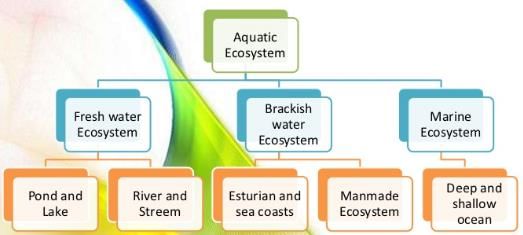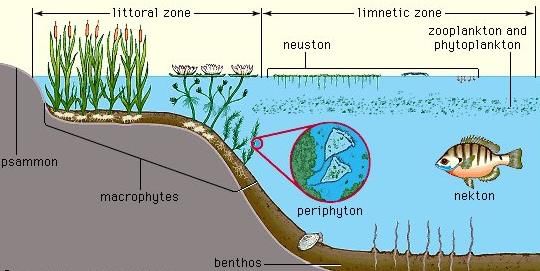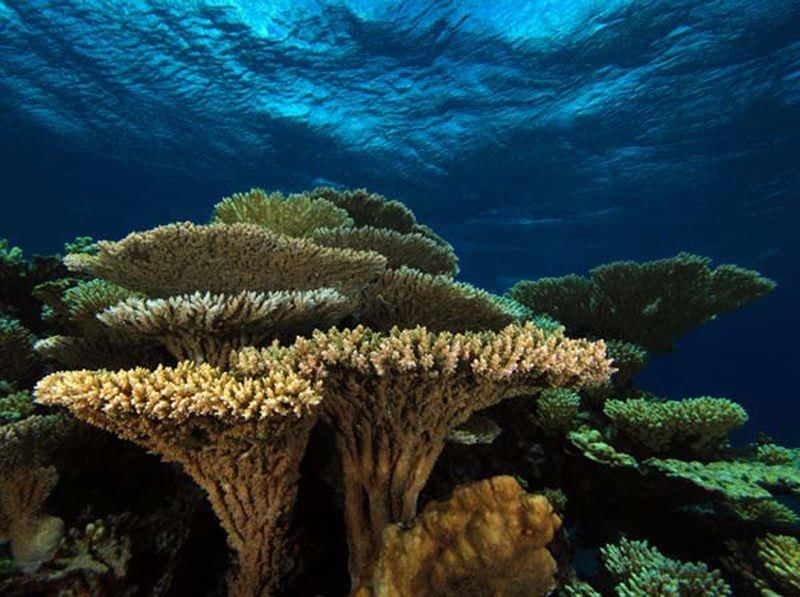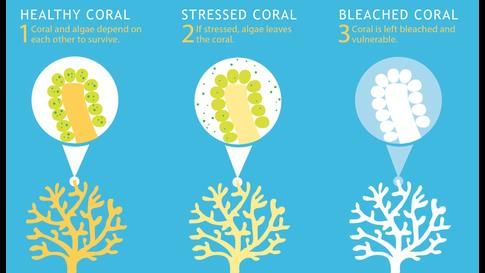Shankar IAS Summary: Aquatic Ecosystem- 1 | Famous Books for UPSC Exam (Summary & Tests) PDF Download
Aquatic Ecosystem
 Classification of Ecosystem
Classification of Ecosystem- Fresh water ecosystems - The salt content of fresh bodies is very low, always less than 5 ppt parts per thousand).
Example: lakes, ponds, pools, springs, streams, and rivers. - Marine ecosystems - The water bodies containing salt concentration equal to or above that of sea water (i.e., 35 ppt or above).
Example: shallow seas and open ocean. - Brackish water ecosystems - these water bodies have salt content in between 5 to 35 ppt.
Example: estuaries, salt marshes, mangrove swamps and forests.
Aquatic Organisms
- The aquatic organisms are classified on the basis of their one of occurrence and their ability to cross these zones.
- Can be classified on the basis of their life form or location into five groups.
 Aquatic Organisms
Aquatic Organisms
1. Neuston
- These are unattached organisms which live at the air-water interface such as floating plants, etc.
- Some organisms spend most of their lives on top of the air-water interface such as water, Striders, while others spend most of their time just beneath the air-water interface and obtain most of their food within the water. Example: beetles and back-swimmers.
2. Periphyton
- These are organisms which remain attached to stems and leaves of rooted plants or substances emerging above the bottom mud such as sessile algae and their associated group of animals.
3. Plankton
- This group includes both microscopic plants like algae (phytoplankton) and animals like crustaceans and protozoans (zooplankton) found in all aquatic ecosystems, except certain swift moving waters.
- The locomotory power of the planktons is limited so that their distribution is controlled, largely, by currents in the aquatic ecosystems.
4. Nekton
- This group contains animals which are swimmers.
- The nektons are relatively large and powerful as they have to overcome the water Currents.
5. Benthos
- The benthic organisms are those found living in the bottom of the water mass.
- Practically every aquatic ecosystem contains well developed benthos.
Factors Limiting the Productivity of Aquatic Habitats
1. Sunlight
- Sunlight penetration rapidly diminishes as it passes down the column of water. The depth to which light penetrates lake determines the extent of plant distribution.
- Based on light penetration and plant distribution they are classified as photic and aphotic zones

(a) Photic zone
- It is the upper layer of the aquatic ecosystems, up to which light penetrates and within which photosynthetic activity is confined.
- The depth of this zone depends on the transparency of water, photic (or. "euphotic") zone is the lighted and usually well-mixed portion that extends from the lake surface down to where the light level is 1% of that at the surface.
(b) Aphotic zone
- The lower layers of the aquatic ecosystems, where light penetration and plant growth are restricted forms the aphotic zone.
- Only respiration activity takes place. (photic-both respiration and photosynthesis take place).
- Aphotic zone is positioned below the littoral and photic zones to bottom of the lake where light levels are too low for photosynthesis.
- This deep, unlit region is also known as the profundal zone.
2. Dissolved oxygen
- Oxygen enters the aquatic ecosystem through the air water interface and by the photosynthetic, average concentration of dissolved oxygen as 10 parts per million by weight.
- Dissolved oxygen escapes the water body through air-water interface and through respiration of organisms (fish, decomposers, zooplanktons, etc.).
- The amount of dissolved oxygen retained in water is also influenced by temperature.
Other limiting factors which influence on Aquatic productivity
(i) Transparency
- Transparency affects the extent of light penetration.
- Suspended particulate matters such as clay, silt, phytoplankton, etc. make the water turbid. Consequently it limits the extent of light penetration and the photosynthetic activity in a significant way.
(ii) Temperature
- The water temperature changes less rapidly than the temperature of air because water has a considerably higher specific heat than air.
- Since water temperatures are less subject to change, the aquatic organisms have narrow temperature tolerance limit.
Lake Ecology
- Anybody of standing water, generally large enough in area and depth, irrespective of its hydrology, ecology, and other character is tics is generally known as lake.
 Lake Ecology
Lake Ecology
Ageing of Lakes
- The nutrient-enrichment of the lakes promotes the growth of algae, aquatic plants and various fauna. This process is known as natural eutrophication.
- Similar nutrient enrichment of lakes at an accelerated rate is caused by human activities and the consequent ageing phenomenon is known as cultural eutrophication.
- In India, natural lakes (relatively few) mostly ile in the Himalayan region, the floodplains of Indus, Ganga and Brahmaputra. Lake ’Sudarshan’ in Gujarat's Girnar area was perhaps the oldest man-made lake in India, dating back to 300 BC.
- Lakes are also classified on the basis of their water chemistry. Based-on the levels of salinity, they are known as Freshwater, Brackish or Saline lakes (similar to that of classification of aquatic ecosystem).
- On the basis of their nutrient content, they are categorized as Oligotrophic (very Low nutrients), Mesotrophic (moderate nutrients) and Eutrophic (highly nutrient rich).
Removal of the nutrients from a lake
- Flushing with nutrient-poor waters.
- Deep water abstraction.
- On-site P-elimination by flocculation/flotation with water backflow, or floating Plant NESSIE with adsorbents.
- On-site algae removal by filters and P-adsorbers.
- On-site algae skimming and separator thickening. Artificial mixing/ Destratification (permanent or intermittent).
- Harvest of fishes and macrophytes. Sludge removal.
Eutrophication
- A syndrome of ecosystem, response to the addition of artificial or natural substances such as the growth of green algae which we see in the lake surface layer is the physical identification of almost entire surface layer is known as algal bloom.
- Nitrates and phosphates through fertilizer, sewage, etc. that fertilize the aquatic ecosystem and Eutrophication. Some algae and blue-green bacteria thrive on the excess ions and a population explosion covers.
- Nitrogen testing is a technique to find the optimum amount of fertilizer required for crop plants. It will reduce the amount of nitrogen lost to the surrounding area.
Harmful Algal Blooms
- Algae or phytoplankton are microscopic organisms that can be found naturally in coastal waters. They are major producers of oxygen and food for many of the animals that live in these waters. Algal blooms can be any colour, but the most common ones are red or brown.
- Most algal blooms are not harmful but some produce toxins and do affect fish, birds, marine mammals and humans.

Use of algae
- Most species of algae or phytoplankton serve as the energy producers at the base of the food web, without which higher life on this planet would not exist.
Why Red Tide is a misnomer?
- "Red Tide" is a common name for such a phenomenon where certain phytoplankton species contain pigments and "bloom" such that the human eye perceives the water to be discoloured.
- Blooms can appear greenish, brown, and even reddish orange depending upon the type of organism, the type of water, and the concentration of the organisms.
- The term "red tide" is thus a misnomer because blooms are not always red, they are not associated with tides, they are usually not harmful, and some species can be harmful or dangerous at low cell concentrations that do not discolour the water.
What are the causes of these blooms?
- Two common causes are nutrient enrichment and warm waters.
Wet Land Ecosystem
- Areas of marsh, fen, peatland/water, whether natural (or) artificial, permanent (or) temporary with water that is static (or) flowing, fresh, brackish (or) salt, including areas of marine water the depth of which at low tide does not exceed 6 metres.
Wetlands Classification
- Inland wetland
(i) Natural - Lakes/ Ponds, Ox-bow Lakes, Waterlogged, Swamp/marsh
(ii) Manmade - Reservoirs Tank, Ash pond - Costal Wetland
(i) Natural - Coral reef, Tidal flat, Mangroves, Salt marsh, Estuary, Lagoon, Creek, Backwater, Bay
(ii) Manmade - Salt pans, Aquaculture
Functions of Wetlands
- Habitat to aquatic flora and fauna, birds.
- Filtration of sediments and nutrients from surface water, Nutrients recycling, Water purification.
- Ground water recharging, Buffer shorelines against erosion.
- Floods mitigation, Genetic reservoir for various species of plants (rice)
- The National Lake Conservation Programme (NLCP) considers lakes as standing water bodies which have a minimum water depth of 3 m, generally cover a water spread of more than ten hectares, and have no or very little aquatic vegetation.
- Wetlands (generally less than 3 m deep over most of their area) are usually rich in nutrients (derived from surroundings and their sediments) and have abundant growth of aquatic macrophytes.
India's Wetland
- Wetlands occupy 18.4% of the country's area of which 70% are under paddy cultivation.
- Inland wetlands > Costal Wetlands
National Wetlands Conservation Programme (NWCP)
- NWCP was implemented in the year 1985-86.
- Under the programme, 115 wetlands have been identified by the Ministry which require urgent conservation and management interventions.
Aim
- Conservation of wetlands to prevent their further degradation and ensuring their wise use for the benefit of local communities and overall conservation of biodiversity.
Objectives
- To lay down policy guidelines for conservation and management of wetlands in the country.
- To provide financial assistance for undertaking intensive conservation measures in the identified wetlands.
- The Central Government is responsible for overall coordination of wetland conservation programmes and initiatives at the international and national levels. It also provides guidelines, financial & technical assistance to the state govt.
- State Governments / UT Administration are responsible for management of wetlands and implementation of the NWCP for ensuring their wise-use.
Criteria for identification of Wetlands of National Importance
Criteria for identification of wetlands of national importance under NWCP are same as those prescribed under the ’Ramsar Convention on Wetlands' and are as given below:
1. Sites containing representative, rare or unique wetland types: Example of a natural or near-natural wetland type found within the appropriate biogeographic region.
2. Criteria based on species and ecological communities
- If it supports vulnerable, endangered, or critically endangered species; or threatened ecological communities.
- If it supports populations of plant and/or animal species important for maintaining the biological diversity of a particular biogeographic region.
- If it supports plant and/or animal species at a critical stage in their life cycles, or provides refuge during adverse conditions.
3. Specific criteria based on water birds
- If it regularly supports 20,000 or more water birds.
- If it regularly supports 1% of the individuals in a population of one species or subspecies of water birds.
4. Specific criteria based on fish
- If it supports a significant proportion of indigenous fish subspecies, species or families, life history stages, species interactions and/or populations that are Representative of wetland benefits and/or values and thereby contributes to global biological diversity.
- If it is an important source of food for fishes, spawning ground, nursery and/or migration path on which fish stocks, either within the wetland or elsewhere, depend. Specific criteria based on water/life and culture
- If it is an important source of food and water resource, increased possibilities for recreation and ecotourism, improved scenic values, educational opportunities, conservation of cultural heritage (historic or religious sites).
Estuary Ecosystem
- Located where river meets the sea. The most productive water bodies in the world.
- The complete salinity range from 0-35 ppt is seen from the head (river end) to the mouth (sea end) of an estuary.
- Coastal lakes which have their connection with the sea through small openings are better known as lagoons or backwaters.
- Acting as a natural water filter.
Estuary Formation
Grouped into four geomorphic categories based on the physical processes responsible for their formation :
(1) Rising sea level
(2) Movement of sand and sandbars
(3) Glacial processes
(4) Tectonic processes
India Estuarine Ecosystem
- The Country has 14 major, 44 medium and 162 minor rivers drains into the sea through various estuaries. Major estuaries occur in the Bay of Bengal.
- Most of the India's major estuaries occur on the east coast. In contrast, the estuaries on the west coast are smaller.
Mangroves
- Are the characteristic littoral plant formation of tropical and subtropical sheltered coastlines.

- Are trees and bushes growing below the high water level of spring tides which exhibits remarkable capacity for salt water tolerance.
- Basically evergreen land plants.
- Growing on sheltered shores, typically on tidal flats, deltas, estuaries, bays, creeks and the barrier islands.
- Require high solar radiation and have the ability to absorb fresh water from saline/ brackish water. Produces pneumatophores (blind roots) to overcome respiration problem in the anaerobic soil conditions.
- Leaves are thick and contain salt secreting glands.
- Exhibit viviparity mode of reproduction, i.e. Seeds germinate in the tree itself (before falling to the ground). This is an adaptive median into overcome the problem of germination in Saline water.
- Crystals of salt on the back of the leaves; others block absorption of salt at their roots.
- The mangroves of Sundarbans are the largest single block of tidal halophytic mangroves of the world.
- Famous for the Royal Bengal Tiger and crocodiles.
- The mangroves of Bhitarkanika (Orissa), which is the second largest in the Indian sub-continent, harbour high concentration of typical mangrove species and high genetic diversity have (additional) special roots such as prop roots, pneumatophores which help to impede water flow and thereby enhance the deposition of sediment in areas (where it is already occurring), stabilize the coastal shores, provide breeding ground for fishes.
- Protects coastal lands from tsunami, hurricanes: and floods release oxygen back to the atmosphere, along with a little methane gas
Coral Reefs
- Coral is actually a living animal.
- Has a symbiotic relationship (each gives something to the other and gets something back in return) With ’zooxanthellae' microscopic algae which live on coral [i.e. instead of living on the sea floor, the algae lives up on the coral which is closer to the ocean surface and so that the algae gets lots of light.]
 Coral Reefs
Coral Reefs - The tissues of corals themselves are actually not the beautiful colors of the coral reef, but are instead clear (white). The corals receive their coloration from the zooxanthellae living within their tissues.
- There are two types of corals:
(i) Hard corals
(ii) Soft corals
Such as sea fans and gorgonians, only the builders of coral reefs are tiny animals called polyps. - As these polyps thrive, grew, then found in tropical and sub-tropical water, there are also deep water corals in colder hard corals build reefs, die, they leave their limestone (calcium carbonate) skeletons behind. The limestone is colonized by new polyps.
- Regions The United Nations Environment Programme reports that there are more cold-water coral reefs worldwide than tropical reefs. There are only about 6 different coral species associated in building with these reefs.
- The largest cold-water coral reef is the 'Rost Reef' off Norway Occur in shallow tropical areas where the sea water is clean, clear and warm, one of the most productive and complex coastal ecosystems with high biological diversity.
Classified depending on their locations
(i) Fringing
(ii) Patch
(iii) Barrier
(iv) Atoll
Among the four major reef areas of India, Andaman and Nicobar Islands are found to be very rice in species diversity followed by the Lakshadweep Islands, the Gulf of Mannar and finally the Gulf of Kachchh.
(i) The fringing reefs are contiguous with the shore and they are the most common - by occurring reef form, found in Andamans.
(ii) Patch reefs are isolated and discontinuous patches, lying shoreward of offshore reef structures as seen in the Palk bay, Gulf of Mannar and Gulf of Katchchh.
(iii) Barrier reefs are linear offshore reef structures that run parallel to coastlines and arise from submerged shelf platforms.
- The water body between the reef and the shore is termed as lagoon. Barrier reefs are seen in Nicobar and Lakshadweep.
(iv) Atolls are circular or semi - circular reefs that arise from subsiding sea floor platforms as coral reef building keeps ahead of subsidence. The examples are the atolls of Lakshadweep and Nicobar.
Coral Bleaching
- Bleaching, or the paling of coral colour occurs when
(i) The densities of zooxanthellae decline.
(ii) The concentration of photosynthetic pigments within the zooxanthellae fall. Coral Bleaching
Coral Bleaching
Ecological causes of coral bleaching
- Temperature (Major Cause)
- Sub aerial Exposure - Sudden exposure of reef flat corals to the atmosphere during events such as extreme low tides, ENSO-related sea level drops or tectonic uplift can potentially induce bleaching.
- Sedimentation
- Fresh Water Dilution Inorganic Nutrients (Example: ammonia and nitrate).
- Xenobiotics - Zooxanthellae loss occurs during exposure of coral to elevated concentrations of various chemical contaminants, such as Cu, herbicides and oil.
Key Initiatives to Protect Marine and Coastal Environments
1. Coastal Ocean Monitoring and Prediction System (COMAPS)- Being implemented from 1991. Assesses the health of coastal waters and facilitates management of pollution-related issues.
- Programme was restructured and modified in 2000-2001 to include pollution monitoring; liaison, regulation and legislation; and consultancy services.
2. Land Ocean Interactions in the Coastal Zone (LOICZ)
- Launched in 1995. Investigates the effects of global change on the coastal zone.
- Aims to develop, on a scientific basis, the integrated management of coastal environments.
3. Integrated Coastal and Marine Area Management (ICMAM)
- Launched in 1998 Aims at integrated management of coastal and marine areas.
- Model plans for Chennai, Goa and Gulf of Kutch being prepared.
4. Society of Integrated Coastal Management (SICOM)
- Launched in 2010, Major national initiative to protect coastal ecosystems.
- A professional body with experts in various aspects of coastal science and management.
5. Institutions for Coastal Management
- The Notification on Coastal Regulation Zone(CRZ), 1991 (as amended from time to time) aims at protecting coastal stretches in India.
- India has created institutional mechanisms such as National Coastal Zone Management Authority (NCZMA) and State Coastal Zone Management Authority (SCZMA) for enforcement and monitoring of the CRZ Notification.
- These authorities have been delegated powers under Section 5 of the Environmental (Protection) Act, 1986 to take various measures for protecting and improving the quality-of the coastal environment and preventing, abating and controlling environmental pollution in coastal areas.
Recent Developments
Wetlands & Ramsar Sites
- As of 2025, India has 82 Ramsar sites covering over 1.33 million hectares — up from 75 in 2023. Newly added sites include Tampara Lake (Odisha), Hirakud Reservoir (Odisha), and Ankasamudra Bird Conservation Reserve (Karnataka).
- The Ministry of Environment, Forest and Climate Change (MoEFCC) launched the National Wetland Restoration Programme in 2024 to restore 500 degraded wetlands by 2030, with funding support from the Green Climate Fund.
- New digital Wetland Health Cards have been introduced, integrating satellite data, field surveys, and community reporting for better monitoring under the National Wetlands Conservation Programme (NWCP).
Lake & River Ecology
- The National Lake Conservation Plan (NLCP) has been merged with the National Plan for Conservation of Aquatic Ecosystems (NPCA). In 2024–25, the NPCA allocated ₹525 crore for rejuvenation of key lakes, including Dal Lake (J&K), Bhojtal (Madhya Pradesh), and Chilika Lagoon (Odisha).
- Artificial aeration and bioremediation projects have shown significant improvement in dissolved oxygen levels in lakes like Bellandur (Karnataka) and Saroornagar (Telangana).
- Harmful Algal Bloom (HAB) alerts have been incorporated into the National Water Quality Portal for timely interventions in eutrophication-prone water bodies.
Coastal & Marine Ecosystem Protection
- India’s coral reef monitoring network, under the Integrated Coastal and Marine Area Management (ICMAM), reported improved live coral cover in parts of the Lakshadweep atolls due to local fishing restrictions and reef restoration using artificial structures.
- The National Coral Reef Action Plan (2024–2030) was launched focusing on reef restoration, sustainable tourism, and climate adaptation strategies. Pilot coral gardening projects in Gulf of Mannar and Andaman Islands have shown up to 60% survival rates.
- New mangrove restoration targets have been set under the National Coastal Mission — adding 10,000 hectares of mangroves by 2030. By 2025, 2,500 hectares were already restored, with major efforts in Sundarbans, Bhitarkanika, and Pichavaram.
CRZ & Coastal Regulation Updates
- The CRZ Notification 2019 remains the governing framework, but in 2024, amendments were made to streamline project clearance timelines for eco-tourism and renewable energy projects in CRZ-II and CRZ-III areas, with stricter EIA norms.
- High-resolution coastal vulnerability mapping (1:10,000 scale) is now mandatory for new CRZ proposals in cyclone and erosion-prone states.
Estuaries & Pollution Management
- The National Estuarine Research and Monitoring Network was initiated in 2024, covering major estuaries like Hooghly, Godavari, Mahanadi, and Mandovi-Zuari for studying salinity dynamics, sediment load, and biodiversity health.
- Strict effluent standards were enforced for industries along estuaries to meet the revised CPCB Class-SW water quality criteria for estuarine and coastal waters.
Climate Change & Aquatic Ecosystems
- IPCC AR6 regional data (2023–24) warns of intensified coral bleaching events in Indian reefs due to marine heatwaves. Lakshadweep and Gulf of Mannar recorded Degree Heating Weeks (DHW) > 8 in 2024, triggering partial bleaching.
- Increased cyclonic activity in the Bay of Bengal (2024) has altered salinity and nutrient inflow patterns in east coast estuaries, affecting fish spawning grounds.
|
745 videos|1444 docs|633 tests
|
FAQs on Shankar IAS Summary: Aquatic Ecosystem- 1 - Famous Books for UPSC Exam (Summary & Tests)
| 1. What is the importance of wetland ecosystems? |  |
| 2. How are wetlands of national importance identified? |  |
| 3. What are the factors limiting the productivity of aquatic habitats? |  |
| 4. What is eutrophication and how does it impact aquatic ecosystems? |  |
| 5. What is the role of mangroves in coastal ecosystems? |  |

















